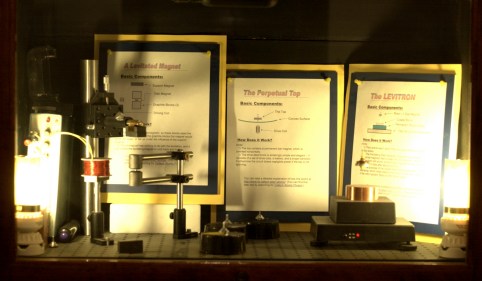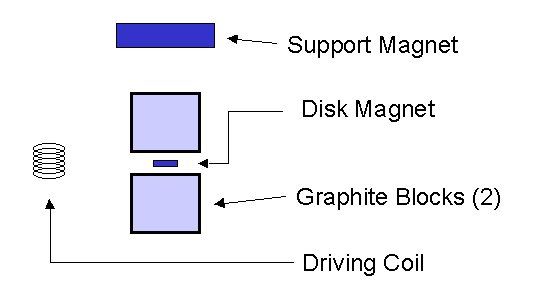 Magnetic
Toys
Magnetic
ToysThe physics display case in the East Bridge hallway at Caltech
It has been shown [1] that it is impossible to levitate, or trap, a magnet using only simple static magnetic fields (just as it is impossible to trap an ion using static electric fields). Two items in the display case, the Levitated Magnet and the Levitron, demonstrate some tricks to get around this fundamental result.
The operation of the Levitated Magnet is fairly simple. The small magnet is held up against gravity by the support magnet, which is oriented to attract the small magnet. While the support magnet alone (without the graphite blocks) is sufficient to lift the magnet against gravity, in this case the small magnet will not be stable at it's equilibrium position. In particular, the support is unstable in the vertical direction -- if the small magnet is perturbed upward the support magnet will attract it more strongly, and it will fly upward. And if the small magnet is perturbed downward the support magnet will attract it less strongly, and it will fall down. On the other hand, the support magnet alone does provide stable trapping in the horizontal directions -- if the small magnet is perturbed horizontally, the support magnet will pull it back.
 The graphite blocks
provide the needed stability in the vertical direction, without changing the stable
trapping in the horizontal directions. Graphite is strongly diamagnetic, so it
tends to repel magnetic dipoles. Placing graphite blocks above and below the small
magnet thus can stabilize the levitated magnet. Calculating the forces is a good
problem in magnetostatics, and is left to the reader [2].
The graphite blocks
provide the needed stability in the vertical direction, without changing the stable
trapping in the horizontal directions. Graphite is strongly diamagnetic, so it
tends to repel magnetic dipoles. Placing graphite blocks above and below the small
magnet thus can stabilize the levitated magnet. Calculating the forces is a good
problem in magnetostatics, and is left to the reader [2].
The drive coil simply produces an oscillating magnetic field that causes the levitated magnet to swing back and forth. Without the drive coil the display is a bit static, and it's hard to see that the small magnet is in fact freely levitated.
It appears that the Levitated Magnet, in the configuration shown here, was invented by Martin Simon at UCLA, although many others have certainly worked on similar devices in the past. This device works well only if the levitated magnet is a very strong rare-earth magnet. Further information can be found at Martin Simon's home page. A somewhat more difficult demonstration involving diamagnetic levitation is the stable trapping of a live frog, which was recently accomplished at the High Field Magnet Laboratory in Amsterdam.
 The point of the
perpetual top is simply that it continues spinning forever, and the challenge is to
understand the driving mechanism. The top is made of plastic, and contains embedded
in it a small permanent magnet, oriented perpendicular to the spin axis of the top.
The base contains a transistor and a coil with two windings, the assembly being driven by
a 9-volt power supply. A schematic of the electrical circuit is shown in the figure.
The point of the
perpetual top is simply that it continues spinning forever, and the challenge is to
understand the driving mechanism. The top is made of plastic, and contains embedded
in it a small permanent magnet, oriented perpendicular to the spin axis of the top.
The base contains a transistor and a coil with two windings, the assembly being driven by
a 9-volt power supply. A schematic of the electrical circuit is shown in the figure.As one pole of the magnet (say the south pole) approaches the coil, a current in induced in winding A, in such a direction as to make the base of the transistor (an NPN) go positive. That makes the emitter-collector current flow through winding B, in the opposite direction to A. The current through B is larger than that of A (due to the amplification of the transistor), so by Lenz's law the magnet pole will be attracted to the coil.
 Note that the induction from A to B is regenerative, which causes the current
pulses in B to be larger. The circuit may be recognized as a Hartley oscillator
circuit. In this case it does not spontaneously oscillate, partly because the Q
factor is quite low, and partly because the transistor is not biased to favor oscillation.
Note that the induction from A to B is regenerative, which causes the current
pulses in B to be larger. The circuit may be recognized as a Hartley oscillator
circuit. In this case it does not spontaneously oscillate, partly because the Q
factor is quite low, and partly because the transistor is not biased to favor oscillation.The beauty of the system is that energy is fed into the spinning top regardless of how the top is spinning. The south pole is pulled toward the coil as it approaches, and as it moves away from the coil there is no force, since the transistor is then nonconducting. Alternately, the north pole feels no force as it approaches the coil, but is pushed away as it recedes. There is no preference to clockwise or counter-clockwise rotation of the top. Also the circuit draws no power (other than a small leakage current in the transistor) when the top is not spinning.
 The
Amazing Levitron
The
Amazing Levitron